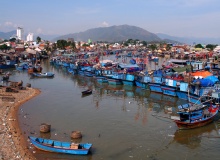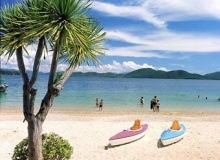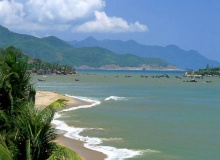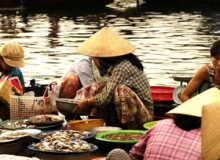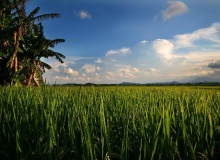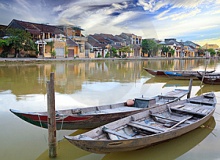Vietnam
Ho Chi Minh | Hanoi | Nha Trang | Hoi An
A country whose economy is booming and is one of the most interesting destinations in Asia
Once synonymous with tragedy and conflict, Vietnam is experiencing a rebirth. Now decades after the U.S. pullout from South Vietnam, the country shows few remaining scars from that conflict or the protracted War of Independence from France that preceded it. Many historical sites have been fully restored, the country's economy is booming and the infrastructure for tourism is developing rapidly.
Visitors need no longer worry about staying in contact with home as internet cafes are everywhere. The ancient and modern coexist: Cell phones and gleaming motorbikes are ubiquitous in the towns and villages, but people still till the rice fields with the help of bullock plows.
The country's history of conflict, both internal and with other, could lead you to conclude that the Vietnamese thrive on a certain degree of contentiousness. That's just not the case. Although older Vietnamese may find the pace of change somewhat dizzying, there is overwhelming support for the advances the country is making. Tourism is helping Vietnam ride the crest of that wave, and the country has become one of the most interesting destinations in Asia.
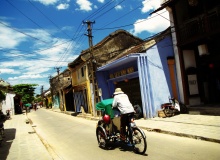
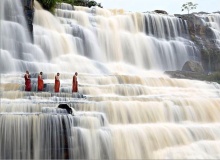
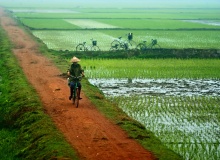
Ho Chi Minh
The Vietnamese people seem to use the names Saigon, Ho Chi Minh City or simply HCMC interchangeably. Ho Chi Minh City is the economic centre of Vietnam, although geographically it's 1,120 km south of Hanoi. With a rapidly growing population, new hotels, chic bars and trendy clubs, Ho Chi Minh City is enjoying its climate of prosperity and growth.
The old Saigon landmarks—the Notre Dame Cathedral, the Rex Hotel, the Hotel de Ville—are still there. But new office towers, built by multinational corporations now setting up shop in Vietnam, are radically changing the skyline. Ho Chi Minh City's millions of motorbikes emit a constant roar and palpable exhaust, and the city's two- and three-hour traffic jams are legendary. Amid all this, there are still nearly 200 temples and pagodas in the city.
History buffs should stop by the Reunification Palace, where the South Vietnamese government officially turned over power to the North in 1975. It's a trip back in time.
On Ho Chi Minh City's doorstep is the Mekong delta, with its burgeoning markets, luminous green rice fields, Khmer pagodas, and fruit and flower orchards.
WHEN TO TRAVEL to Ho Chi Minh
The most comfortable time to visit climatically is in the seasons between December and April as the place exhibits a dry climate during this time of the year. Although it is hot, the nights are very cool and pleasant.
From May to October the wet season follows while July to November the typhoon season reigns supreme as violent tropical storms can target the coasts any time.


Hanoi
Hanoi, the capital of North Vietnam 1954-76 and of French Indochina for 70 years before that, is a river city 1,120 km north of Ho Chi Minh City. It has, alas, been forever changed by the introduction of literally millions of motorbikes, which dodge, weave and honk through the narrow streets of the Old Quarter and down the broad, old avenues of the Colonial District.
Motorbike taxis (motos) are everywhere, though, especially near hotels and restaurants. On the saddle behind someone who knows how to navigate the chaos, travelling around Hanoi can be a kind of terrifying fun. Automobile taxis are also available, but they're more expensive.
Hoan Kiem Lake is the heart of the city. Stroll along the pedestrian paths around its edge, then enjoy an espresso and pastry at the lakeside cafe. Cross red-painted Rising Sun Bridge to enjoy the relative quiet around Ngoc Son temple. Visit the Temple of Literature, the only remaining original building at the 1,000-year-old Hanoi University. Take a taxi northwest of the lake to Ho Chi Minh's Mausoleum.
Several museums are worth visiting: The Museum of Ethnology, the Museum of History and the Museum of Women that lauds Vietnamese women's role in military and domestic history.
WHEN TO TRAVEL to Hanoi
The climate of Vietnam varies greatly from north to south due to its long and narrow territory and you can never judge Hanoi's weather from the knowledge of other Vietnamese regions. Hanoi is most pleasant from February to April and September to November avoiding the heat and the rain.


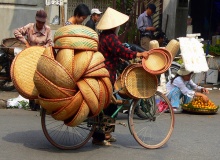
Nha Trang
Nha Trang, set on Vietnam's mountainous coast 400 km northeast of Ho Chi Minh City, is best known for its golden beaches, clean air and proximity to some paradisical islands. The city is a pleasant seaside resort with a relaxed atmosphere. It is a popular stop on the coastal tour route between Ho Chi Minh City and Hanoi. The town is easily accessible by daily flights and trains from Ho Chi Minh City and Hanoi, as well as by bus from Dalat, Da Nang and Hue.
Nha Trang Bay is famous for its superb beaches with fine sand, turquoise waters, and excellent scuba diving and snorkelling. In addition to its beach, Nha Trang has many appealing attractions, including the historic Long Son Pagoda, Po Nagar Cham Towers, an ancient temple site, City Square and the Nha Trang Oceanography Institute, home to rare patterns of coral and sea life.
For the best view of the area's mountainous coastline, take a trip to Hon Chong (Husband Rocks), a granite promontory that extends into the sea. From Nha Trang the most frequently visited islands are Hon Mot and Hon Mun. You can join a tour for a day trip of scuba diving or snorkelling.
WHEN TO TRAVEL to Nha Trang
Nha Trang is extremely lucky to not be influenced by monsoon winds that turn the rest of southern Vietnam into water six months every year. Nha Trang has a warm and fair climate nearly all year round, with the exception of late October, November and early December.
_________________________________________________________________________________
Hoi An
The colorful market town of Hoi An, on the Thu Bon River and 640 km southeast of Hanoi, was a major port in centuries past, with ships arriving from all over the world for cargoes of silk and other fabrics, sugar, tea and ceramics. Hoi An's traditional Vietnamese architecture has been preserved, and there are many historic temples and pagodas in the area.
Popular sights include the 18th-century Tan Ky House, the Phuoc Kien Assembly Hall, the Chaozhou Assembly Hall and the Japanese-style covered bridge, the town's most famous landmark.
Hundreds of shops in Hoi An sell handmade silk and cotton garments, and custom tailoring is fast, inexpensive and mostly of good quality.
Hoi An is also known for its silk lanterns. In the old section of town after dusk, you'll see the streets beautifully lit with these lanterns. If you time your visit right, you may see the lantern festival held in November on the eve of the full moon.
At My Son, just southwest of Hoi An, are Vietnam's finest Cham ruins, a complex of about 70 temples, houses and other structures.
WHEN TO TRAVEL to Hoi An
February and April are the best time to visit Hoi an when rainfall is low and temperatures are pleasant. During October and November, rains can be frequent and heavy. Time your visit to Hoi An to coincide with the 14th day of each lunar month for the Full Moon festivals. The town becomes the stage for traditional songs, dancing, games and food, with lanterns lining all of the streets.
